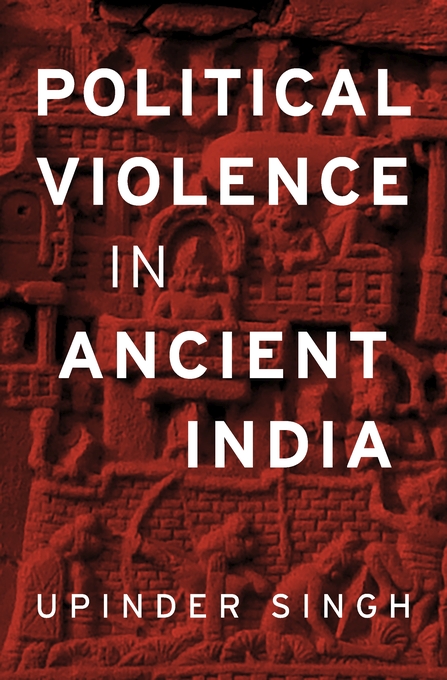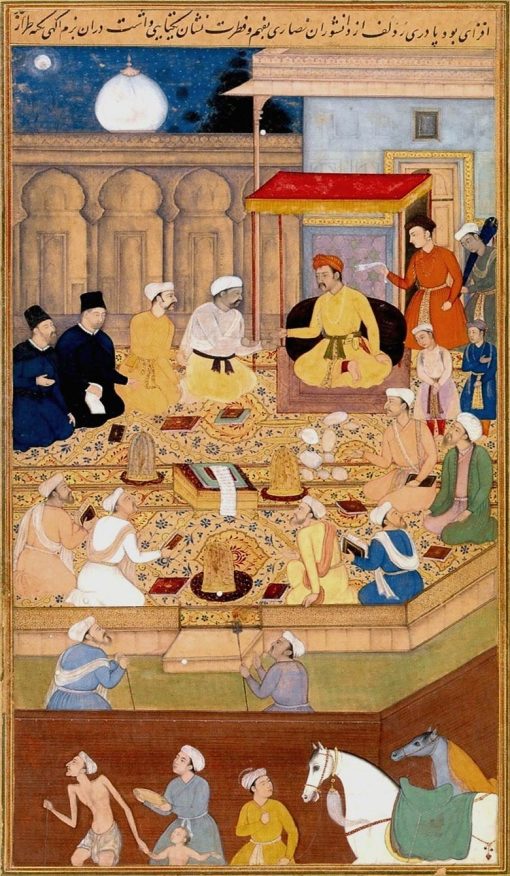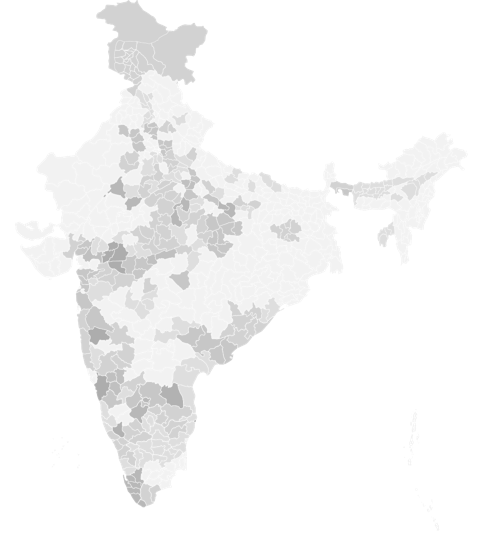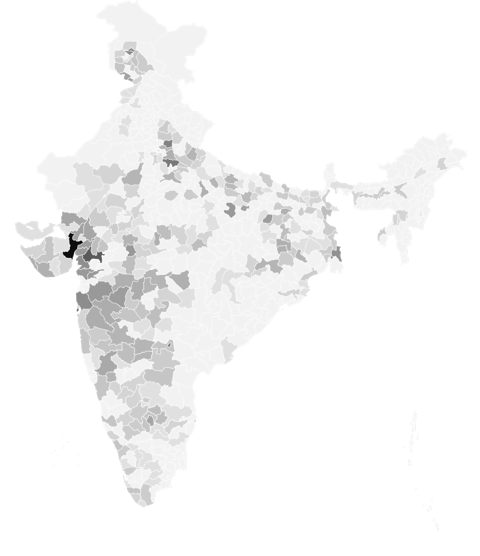“The hermetically cloistered figures of rosary-fondling Sufis and sabre-rattling ghazis, (saints and warriors) even when yoked to the cause of good pluralistic politics, produce bad history. And I say this because, faced as we are with an insistence on a Manichean clash between Islam and Hinduism in India’s medieval past, historians need to fashion newer histories of this encounter.”
– Shahid Amin
(“Un Saint Guerer: Sur le Conquete de l’Inde du Nord par les Turcs aux XI siècle”,
Annales, Histoire, Sciences Sociale 60 anne-n.2, Mars-Avril 2005:265-92)

The medieval and the early modern period, like any other temporal stretch in history, is marked by violence, communalism, warfare, rebellions, agrarian distress, and other not so glorious processes and events, besides a history of accommodation, negotiation, acculturation, and syncretisation. While the likes of Elliot and Dowson, like their Orientalist predecessors, in what Edward Said called the “academic conquest” of Middle Asia, identified the Muslim “other” to tell a history of oppression and displacement by the might of the sword, the newly decolonized nation’s secular-nationalist historians rendered a story of unprecedented syncretism and pluralism, as a result of their well-meaning myopia. While the imperialist tenor of producing a sense of alterity in seeing communities as ageless monolithic formations at loggerheads with one another, evident in James Mill’s periodisation of India’s past, survived in the ahistorical works of people like Sita Ram Goel and PN Oak, it re-fashioned a motley body of historically embedded grievances and the memory of violence and trauma to secure a place in the altered political context. On the other hand, the secular historians, in possession of sophisticated methods of inquiry, chose to ignore the history of conflicts and the volatile question of pre-modern communalism. This selective amnesia, perhaps flowing from the anxieties of communal violence in the wake of the Partition, is best illustrated in the repetitive citation of Akbar’s Sulh-i-kul as the exemplar of medieval religious policy, and less frequently, Amir Khusrau’s multilinguality as an evidence of the adoption of the indigenous-vernacular by an ethnic other, who became the very voice of India’s syncretism- tuti-i Hind. In these secular histories, such was the assimilative power of the “Indo” (Hindu/local?), and equally seamless was the fusion of the “Islamic” (Muslim/foreign?), later to be replaced by the more nuanced “Indic” and “Islamicate” respectively.
In a recent thought provoking piece addressing the pre-colonial history of Hindu-Muslim conflicts in India, first published in IAPS dialogue and later republished by scroll.in, Ajay Verghese attempts a reassessment of both, religious conflicts in India before the advent of the British, and its historiography. While he rightly signals towards the secular-nationalist corpus discussed briefly in the preceding paragraph, he alleges that the long lineage of Hindu-Muslim conflicts in India is left out of “standard historical accounts”. This reminded me of three historians whose works are introduced at the undergraduate level as essential readings — Christopher Bayly, Sanjay Subrahmanyam, and Shahid Amin. It shall suffice to note the year of publication of their respective works relevant to the current topic — Chris Bayly’s “The Pre-History of ‘Communalism’? Religious Conflict in India, 1700-1860” was published in 1985; Subrahmanyam’s “Violence, Grievance, and Memory in Early Modern South Asia” in 2005, and Amin’s “Conquest and Community: The Afterlife of Warrior Saint Ghazi Miyan” in 2015. One could say that such works are fewer in number, or question the “reach” or dissemination of these literatures, but cannot deny the existence of such “standard historical accounts.”

The author quotes Vivekananda from his iconic 1893 Chicago speech, touches upon Gandhi’s emphasis on equality between religions, and refers to Nehru’s idea of assimilation and synthesis as “the whole history of India”. This happens in a similar vein in Professor Upinder Singh’s brilliant recent publication, Political Violence in Ancient India (Harvard University Press, 2017). She debunks the myth of a non-violent past created by the likes of Gandhi and Nehru to facilitate the project of nation-building. Singh questions, if
“India possess the ability to recognise and confront the realities of her violent past and present, and carry forward the debate on political violence with the seriousness with which intellectuals initiated it over two thousand years ago.”
Though violence as a strategic device of state formation in the integrative early medieval polities has been discussed by Hermann Kulke and others, Singh’s work stands out as a dialogue between the remote past and the contemporary, bringing to surface the anxieties of acknowledging a violent past.
Similarly, Varghese’s project, in collaboration with Roberto Foa at the University of Melbourne, traces the pre-colonial origins of Hindu-Muslim conflicts in India, which has been conveniently attributed to the British policy of “divide and rule”. The project “critique(s) this rather truncated and romanticised view of the origins of Hindu-Muslim conflict.” They argue that religious identities and religious conflicts in India predate the colonial period, and consider the 17th century battles between Aurangzeb and Shivaji, a watershed moment. The first argument is that “consolidated Hindu and Muslim identities existed before the British.” The author states that the term Hindu “clearly” had “religious connotations from the very beginning.” For the author, it is made clear by David Lorenzen asking why Muslims born east of the Indus did not call their children Hindus if it were merely a geographical term. Firstly, to assume that terms remain changeless over time is ahistorical. B D Chattopadhyay has convincingly illustrated how specific ethnic labels like yavana, mlechha and turushka acquired more generalized connotations to imply the “other”, shedding their early historical specificities by the early medieval period. Secondly, a geographical label is not devoid of cultural meanings, and thus “Hindu” could also entail the practices of the people born east of the Indus river — their quotidian might be different from that of the new settlers. Add to this the nostalgia of a distant home land and the experience of migration. We have seen how itinerants cling to older place names and group affiliations as recourse to the comforting abyss of memory — significant here is Susan Lees and Daniel Bates’ work on nomadic pastoralism in Middle Asia.

A Folio from a Manuscript of Kitāb-i Nauras, National Museum, Delhi/
Image Courtesy: Arts and Culture
The author further argues that “the British did not construct Hindu and Muslim identities — these communities were consolidated before colonial rule.” While there’s no doubt that Hindu and Muslim identities existed in the pre-colonial period, one fails to recognise the nature of these identities in the early modern world, which was marked by the presence of multifarious identities and replete with instances of “crossing-overs” that account for its hybridity and cosmopolitanism. To see the two communities as zealously guarded, fixed entities seems like an attempt to read the present in the past, instead of tracing the process of identity formation over time. Identities are re-fashioned and re-presented, and simplistic projections preclude any discussion on their dynamism and changeability. One could cite a zillion instances to illustrate the nature of early modern cosmopolitanism, ranging from the “Islamicate” courtly culture of the Vijayanagara Rayas to the odes to Saraswati, Ganesh, Mohammad, and Gesu Daraz penned by Ibrahim Adil Shah II in his Kitāb-i-Nauras, from the incorporation of rasa aesthetics in the medieval Sufi romances to the worship of Satya Pīr on the frontiers of Bengal. It is important to acknowledge that religious conflict did erupt in this milieu also, which the author does. But it is reductive to not locate the identities being discussed in their setting — almost like having a text without its context. A part of the argument debunks the myth of the colonial project. But one cannot ignore the contribution of the British in crystallizing or, let’s say, limiting such identities. As Thomas and Barbara Metcalf note, Hastings’s jurisprudence, which eventually led to the codification of civil law in the form of a “Code of Gentoo Laws” in 1776, was informed by a conviction that distinct and separate codes of law existed for Hindus and Muslims. “The Laws of the Koran with respect to Mahomedans, and those of the Shaster with respect to the Gentoos shall be invariably adhered to”, wrote Hastings. Perhaps stretching it a bit too far, Metcalfs opine that this binary “helped shape how Indians constructed identities for themselves in subsequent years.” While there is a need to question this position, one cannot deny that codification and canonisation does lead to the crystallisation of identities. Privileging the text over practices and traditions that make the everyday of the ‘Hindu’ or ‘Muslim’ way of living has been justly critiqued.
 Mughal artwork depicts Emperor Akbar presiding over discussions in the Hall of Religious Debate, ca. 1600. / Image credit: Chester Beatty Library, Dublin, republished from Stanford News
Mughal artwork depicts Emperor Akbar presiding over discussions in the Hall of Religious Debate, ca. 1600. / Image credit: Chester Beatty Library, Dublin, republished from Stanford News
In their second argument, Verghese and Foa reiterate that pre-British Hindu-Muslim conflict “dates specifically to the late-17th century conflicts between the Mughals and the Marathas.” Their analysis is premised on a new dataset of original data on Hindu-Muslim conflict over a span of 850 years (1000-1850 CE).It shows that religious conflict emerged as a significant problem after 1670. Their study contends that “the areas where Aurangzeb and Shivaji engaged in conflict in the 17th century — in Western India, around present-day Maharashtra and Gujarat — are the most riot-prone districts of contemporary India.” This is supplemented by two maps.
 Precolonial Hindu-Muslim conflict, 1000-1850 A.D. Based on data collected by Ajay Verghese and Roberto Foa. Darker shading indicates higher levels of violence | Image courtesy Scroll
Precolonial Hindu-Muslim conflict, 1000-1850 A.D. Based on data collected by Ajay Verghese and Roberto Foa. Darker shading indicates higher levels of violence | Image courtesy Scroll
The first map shows areas in conflict from 1000-1850 CE, in different shades of grey — darker shade indicating higher levels of violence. First, it is a map without a key, and thus fairly unnavigable. Second, what exactly is the index of violence, and how does one quantify it? Third, to compress 850 years of history in the form of a single dataset, and represent it geographically in a present-day map (although it doesn’t show internal boundaries, it demarcates, and hence limits India from the rest of South and Central Asia) seems lopsided. Do we assume that the regions in South Asia experienced the same intensity of violence without any variation over a period of 850 years?
 Postcolonial Hindu-Muslim riots, 1950-1995 A.D. Based on data collected by Ashutosh Varshney and Steven Wilkinson | Image courtesy Scroll
Postcolonial Hindu-Muslim riots, 1950-1995 A.D. Based on data collected by Ashutosh Varshney and Steven Wilkinson | Image courtesy Scroll
The second map shows post-colonial Hindu-Muslim violence, 1950-55 CE.Placed next to the first map, the shades of grey do converge. More nuanced findings of the project, supported by solid evidence, could indeed reveal interesting parallels between the pre-colonial and the post-colonial. The argument that the areas where the Mughals and Marathas engaged in conflict are the most riot-prone districts in contemporary India, is fresh and engaging, and promises new findings. However, this approach appears to be state-centric. It perhaps gives too much agency to the political formations of the Mughals and Marathas. Can we also think about regional/peripheral experiences of violence? Is it possible to prepare a similar map based on people’s narratives from the margins? Can looking beyond textual sources like Saqi Mustad Khan’s Maasir-i-Alamgiri to narrate alternative experiences of religious violence, which could perhaps complicate the dataset?
Shahid Amin’s riveting work, for instance, on the afterlife of Syed Salar Masud (Ghazi Miyan), a fictitious nephew of Sultan Mahmud of Ghazna, goes beyond the only extant hagiography of the conqueror-saint, Mirat-i-Masudi, to include the popular folklore culled from the Awadhi and Bhojpuri ballads sung by Dafalis. They show significant divergence from the Indo-Persianate textual histories of Turkish conquest and violence. Such kind of evidence complicates the binary within which Verghese works. In the Awadhi and Bhojpuri ballads, Ghazi Miyan is revered by Hindus and Muslims alike.While one cannot deny the history of bloodshed and warfare on the Gangetic plains, Amin’s work brings to light the textured terrain of community memory — how things are remembered, dismembered, forgotten, constructed and narrated. Ghazi Miyan is both a pious iconoclast and a protector of cows, his Central Asian roots are unbreakable and yet he enjoys the Indian paan and finds solace under the mahua tree. Amin’s work opens up a world of possibilities beyond binaries.
The wide range of sources that Amin surveys, and the interplay of fact, belief, and memory, makes us ponder over the possibility of an anthropology of violence. Sanjay Subrahmanyam, in his “Violence, Grievance, and Memory in Early Modern South Asia” notes that “the memory of social violence was not necessarily divisive, so long as it was not treated in the mode of grievance.” The case of Ghazi Miyan, Subrahmanyam argues, is that of “incorporative violence”. While the stories in circulation never deny the core tale of conquest and iconoclasm, “they choose to emphasise other, incorporative, pan-sectarian aspects.” He also notes how there have been concerted efforts at translating the “incorporative” to the “exclusionary”. This is based on “grievance collection”, by emphasising on the violence of the past. It would be interesting to investigate the role of memory and grievance in the regions of contemporary conflict mapped out in the first map, which converge with their pre-colonial predecessors.
Lastly, I wonder if the Mughal versus Maratha binary could be understood as Hindu versus Muslim. Mughal kingship did bank on the trope of Islamic millenarianism, and the Maratha state was fashioned as a Hindu Swarajya, evident in the Brahmanical structures of authority, rituals, and stratification While acknowledging that Hindu-Muslim identities and conflict predate colonial rule, one wishes to take cognisance of the “fuzziness” that indeed characterised early modern cultural formations. While the assimilative nature of the Mughal state has been widely discussed, one should remember that the Maratha state and court culture was nurtured by what Andre Wink calls a strong “Islamic impress”. The use of terms like “bakhar”(derived from the Persian “khabar”) is one of the many instances of this co-mingling. Devoid of this “fuzziness”, will the early modern still be accommodative of individuals like Anand Ram Mukhlis? A Persianised Khatri from late Mughal Shahjahanabad, Mukhlis’s response to a desecrated Shiva temple in Sambhal turned into a mosque on Babur’s orders was, “earlier too it was a place of worship, and even now it is a place of worship.” Mukhlis was not the poster boy of secularism; he was one amongst many in his community. The remnants of past violence did not stir a sense of grievance in him. And as Subrahmanyam notes, it was possible for him “to remember and confront an unfortunate past with irony and equanimity, just as he could reflect with those very same qualities, on his own identity and that of his (explicitly identified) community.”
Conflict, in itself is a complex phenomenon and doesn’t necessitate the clash of two belligerents. Its performance is amorphous and, in a way, irretrievably lost to us. The experience of violence is unique, for both individuals and communities alike. To generalise the telling of violence and capture it in a frame leads to the loss of history of the intimate narration of conflict, the contraction of the archive. Moreover, violence is never unidimensional; it happens at the intersection of various forces. We know how women’s experience of violence was different from that of men at the time of Partition, and, subsequently, in 1984, 1992, and 2002, even though the driving force behind these riots was religious identity and communalism. I fear that the quantification of conflict might rob it of its complexity, the inextricability of the various ingredients that fuel violence, and, in turn, belittle the unique experiences of violence of individuals. Could there really be only three shades of grey for a span of 850 years?




